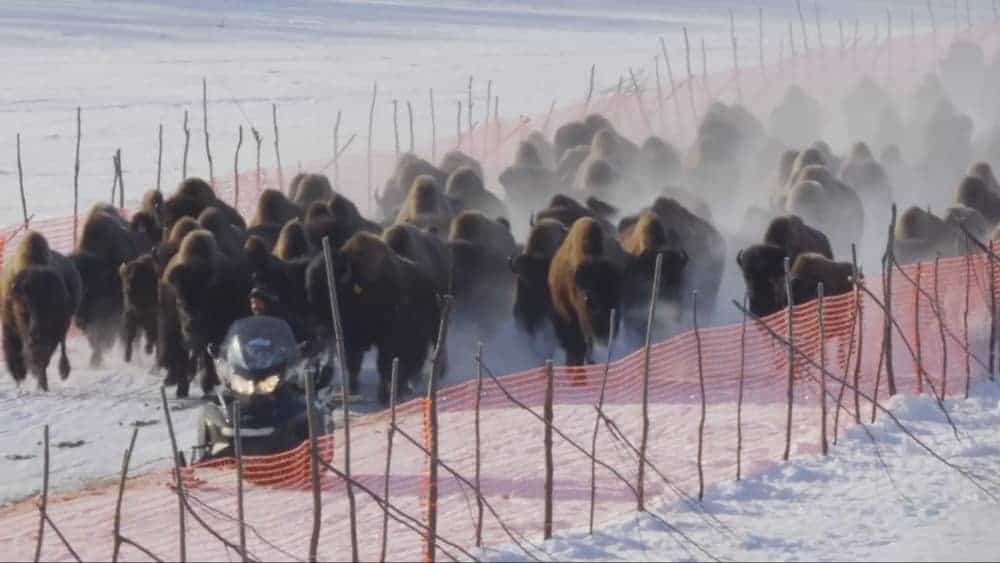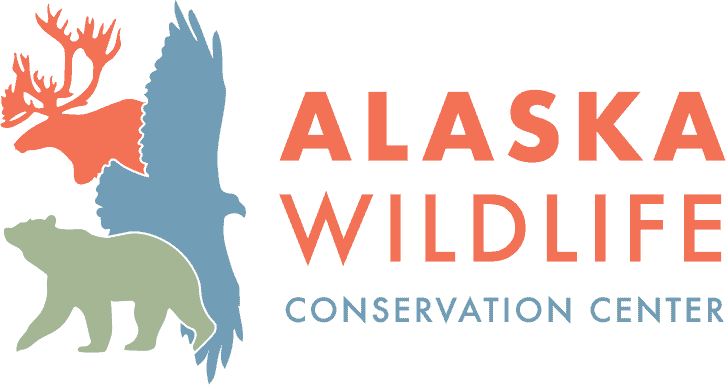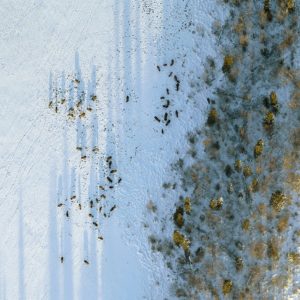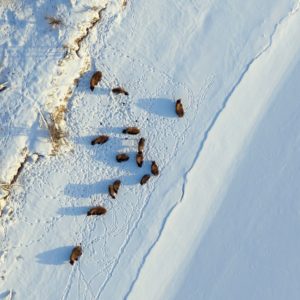Wood Bison Restoration
Reintroduction of Wood Bison back to their natural habitatFor the last 10,000 years, the Athabascan people of Alaska relied on the wood bison for food, clothing, and shelter. Then the wood bison disappeared. North America’s largest land mammal, a victim of ecological change and overhunting, were thought to be extinct. But thanks to one of the world’s greatest conservation projects, wood bison have returned to Alaska.
The Alaska Department of Fish and Game made the commitment over 25 years ago to return wood bison to their native range in Central-Alaska in partnership with the Alaska Wildlife Conservation Center, who currently cares for the only captive herd in the United States. Following the state’s acquisition of wood bison and years of careful management by AWCC, 130 wood bison were successfully released into the wild in spring of 2015.
History
This magnificent animal stood in the doorway of extinction with its numbers crashing to fewer than 300 at the turn of the 20th century. If not for the work of conservationists from the early 1900s to the present, this stalwart creature would surely have joined the ranks of the dinosaurs and wooly mammoth. Efforts to restore free-ranging wood bison populations in parts of their original range in Alaska began over 25 years ago.
Conservation and education remain a primary focus for AWCC, and for our largest conservation project, we partnered with the Alaska Department of Fish and Game (ADF&G) to restore Wood Bison to Alaska. AWCC had received permits to have Wood Bison through the U.S. Fish and Wildlife Service’s Office of Authority’s Endangered Species. In 2005, a Memorandum of Understanding between AWCC and ADF&G was signed, outlining the responsibilities for AWCC in the captive management of Wood Bison. At the time, AWCC had genetically-pure plains bison onsite. These animals were moved to Sand Point, Alaska to be managed by the Native Alaskans in the region, where they remain today. In 2006, 13 Wood Bison from Canada were transferred to AWCC. A captive breeding program began, and in 2008 60 Wood Bison were brought to the AWCC from Elk Island, funded through a grant from Turner Endangered Species Fund to the State of Alaska’s Fish and Game Department. AWCC devoted 250 acres to Wood Bison habitat. The herd had grown to 150 plus healthy, generically-pure animals.
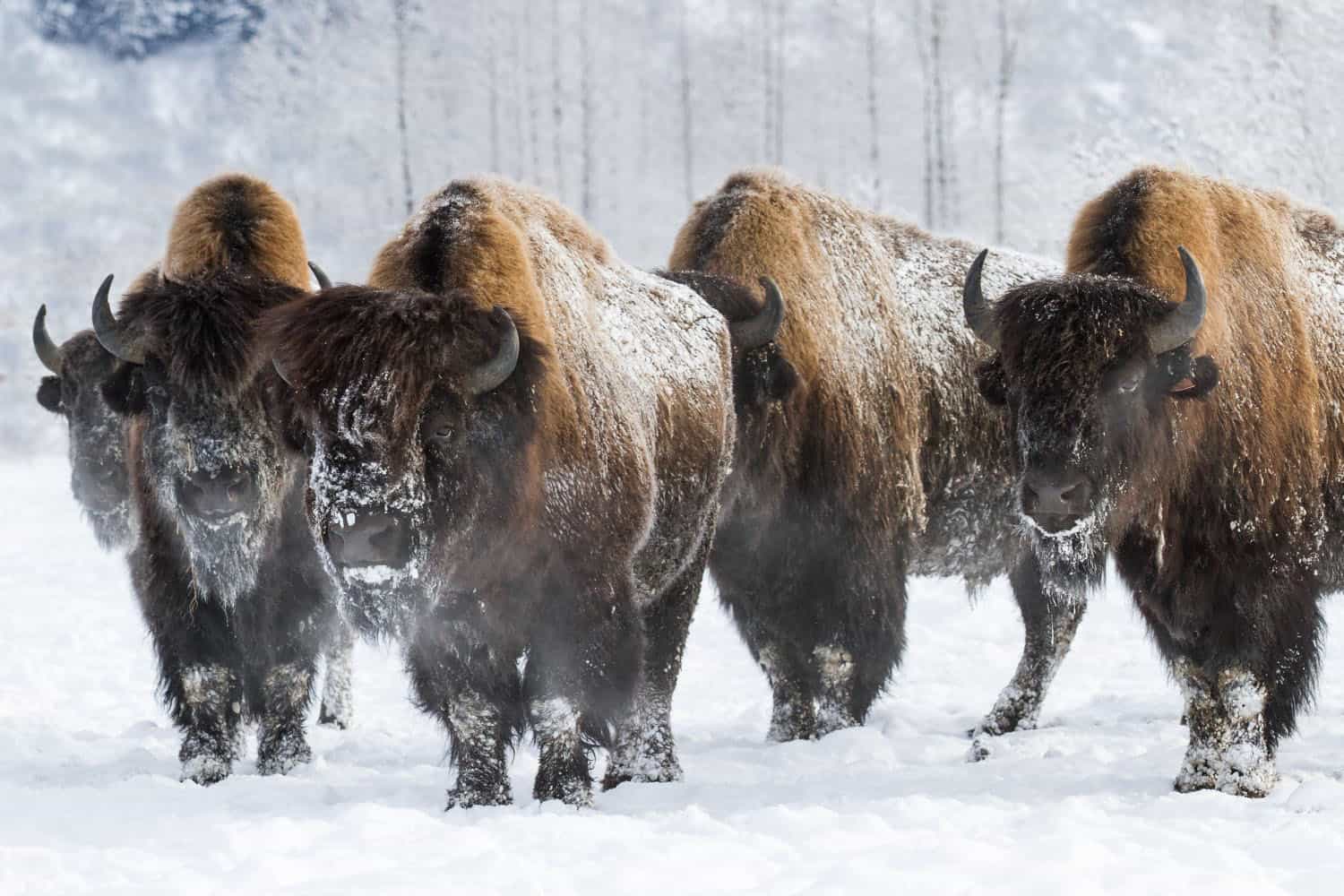
AWCC worked diligently with the Alaska Legislature, local communities, and national media to provide education on the Wood Bison Reintroduction Project. Community presentations and other forums increased public awareness of the Wood Bison Reintroduction Project and its importance to the State of Alaska and the conservation effort nationwide. The Alaska business community showed tremendous support in providing services and goods at little or no cost. As an example, hay delivery for the length of the project (over 7 years) was provided at no cost. Grants from local businesses aided in the overall costs of the project. Volunteers came together and helped erect fences and feeders for the wood bison herd. This project was truly embraced by Alaskans.
Wood bison were downlisted from “endangered” to “threatened” status in 2012. A special regulation was adopted by the U.S. Fish and Wildlife Service in May 2014 declaring them a Nonessential Experimental Population under the 10(j) section of the Endangered Species Act. Among other things, this status stipulates that critical habitat cannot be designated for wood bison, and allows hunting based on sustained yield principles, as established by ADF&G. This ruling allowed for the reintroduction to take place, and those involved began planning for the release in the following spring.
The Wood Bison Management Plan was developed by a diverse group of individuals representing 28 interest groups which included local communities, regional population centers, landowners, Alaska Native interests, wildlife conservation interests, industry, and State and Federal agencies. The project cultivated an unprecedented spirit of sharing and finding common solutions, which guided plan development.
A special regulation was adopted by the U.S. Fish and Wildlife Service, declaring wood bison a Nonessential Experimental Population under the 10(j) section of the Endangered Species Act. Among other things, this status stipulates that critical habitat cannot be designated for wood bison, and allows hunting based on sustained yield principles, as established by ADF&G. This particular regulation allowed for the release efforts to continue.
30 wood bison bulls were transferred to the release site by a barge, which floated down the Innoko river to meet the remote area occupied the female herd. After a successful transport, all 130 wood bison were released into the wild.
During the spring of 2017, approximately 25 calves were born, which was higher than the previous two years. The calves born in 2017 were born earlier and had a higher survival rate than any other year.
The majority of the wood bison herd have stayed within about 50 miles of their release site near Shageluk. A few young adult bison have explored new areas, traveling as far north as the upper Noatak drainage and as far south as the Kuskokwim.
For more information and updates on the wood bison, read the Wood Bison News, Spring 2018 created and produced by the Alaska Department of Fish and Game, Division of Wildlife Conservation.
Wood bison reintroduced in Southwest Alaska see another year of loss, but with a silver lining
By Mary Auld, KUAC – Fairbanks -October 21, 2020
Read full article HERE.
Biologist Tom Seaton’s (ADF&Gs) latest survey: he flew in summer 2021, and the herd has grown by 26 calves! That’s one of the highest calving rates the herd has seen post-release.
“That means a 10% growth since 2020. At this point we’re hoping for a mild winter, or rather, “late winter.” where there is not a lot of ice/snow or freeze/thaw events happening since that seems to affect the herd the most. If they can avoid that, it would hopefully equate to a low annual mortality rate, and another year of high calving rates!” Sarah Howard, AWCC Curator
Alaska Department of Fish & Game 2022 Update: 2022 was a great year for wood bison restoration in Alaska and a record setting year of growth for the wild Lower Innoko and Yukon Rivers herd. On November 28th, ADF&G biologists surveyed the landscape, and they found and photographed 19 groups of bison. This included group sizes from single bulls up to 52 animals.
The wild herd showed an overall 45% growth over last year, with a minimum count of 150 bison in 2022. 19% of the growth occurred naturally from a good calf crop and high survival of yearlings and adults. The other 26% of growth occurred because of the release of 28 captive yearlings into the population in August. The captive yearlings were imported from Canada in April of 2022.
The wild wood bison population is currently around 51% calves and yearlings, which indicates that the herd also has high potential for future growth. Large cohorts of young animals are the first step necessary for a growth spurt in wild populations of ungulates. As this large young cohort ages, it will significantly increase the number of cows of reproductive age, creating more calves and a higher growth rate for the population. Bison cows are most reproductive from 3 to 20 years of age.
Photos © ADF&G
The Release
In March 2015, transportation of wood bison to their new home in Shageluk, Alaska began. Loading 100 Wood Bison into special containers, they were transported to Anchorage, Alaska where they were loaded onto a C130 aircraft and flown to Shageluk’s Innoko Valley. They are now roaming free– a species returned to Alaska after a 100-year absence.
There are currently no other wood bison in Alaska, although there are plains bison in several locations. AWCC has plans for additional wood bison releases in the future and will work with ADF&G in their efforts. With the recent completion of Bison Hall at the AWCC, this new facility pays an educational tribute to the Wood Bison Reintroduction Project. This space provides room to accommodate year-round education for school groups, as well as community and visitor use. Currently, no facility is dedicated to education exclusively. The “working barn” was built for storage and space for daily animal care.
